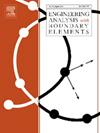一维和二维时间分数Kuramoto-Sivashinsky方程的无网格技术的开发与分析
IF 4.1
2区 工程技术
Q1 ENGINEERING, MULTIDISCIPLINARY
Engineering Analysis with Boundary Elements
Pub Date : 2025-10-06
DOI:10.1016/j.enganabound.2025.106494
引用次数: 0
摘要
涉及卡普托导数的时间分数Kuramoto-Sivashinsky方程(TFKSE)提供了一个描述火焰锋面图案形成的模型。基于卡普托分数阶导数的L1方法,提出了一种构造TFKSE时间离散化的数值格式。在此基础上,提出了采用三角基函数的后向代换法(BSM)进行数值逼近。BSM的第一部分涉及边界数据的逼近,第二部分使用基函数逼近校正函数。对该方案进行了数值分析,并在一维和二维域上对问题进行了讨论。本文章由计算机程序翻译,如有差异,请以英文原文为准。
The development and analysis of a mesh-free technique for 1D and 2D time-fractional Kuramoto-Sivashinsky equation
The time-fractional Kuramoto–Sivashinsky equation (TFKSE) involving Caputo derivatives provides a model that describes pattern formation on flame fronts. We develop a numerical scheme to construct a time discretization for the TFKSE based on the method for the Caputo fractional derivative. Furthermore, the proposed backward substitution method (BSM), which employs trigonometric basis functions, is used for numerical approximation. The first part of the BSM involves the approximation of the boundary data and the second part approximates the correction functions using basis functions. The numerical analysis of the scheme is presented, and the problem is discussed in one- and two-dimensional domains.
求助全文
通过发布文献求助,成功后即可免费获取论文全文。
去求助
来源期刊

Engineering Analysis with Boundary Elements
工程技术-工程:综合
CiteScore
5.50
自引率
18.20%
发文量
368
审稿时长
56 days
期刊介绍:
This journal is specifically dedicated to the dissemination of the latest developments of new engineering analysis techniques using boundary elements and other mesh reduction methods.
Boundary element (BEM) and mesh reduction methods (MRM) are very active areas of research with the techniques being applied to solve increasingly complex problems. The journal stresses the importance of these applications as well as their computational aspects, reliability and robustness.
The main criteria for publication will be the originality of the work being reported, its potential usefulness and applications of the methods to new fields.
In addition to regular issues, the journal publishes a series of special issues dealing with specific areas of current research.
The journal has, for many years, provided a channel of communication between academics and industrial researchers working in mesh reduction methods
Fields Covered:
• Boundary Element Methods (BEM)
• Mesh Reduction Methods (MRM)
• Meshless Methods
• Integral Equations
• Applications of BEM/MRM in Engineering
• Numerical Methods related to BEM/MRM
• Computational Techniques
• Combination of Different Methods
• Advanced Formulations.
 求助内容:
求助内容: 应助结果提醒方式:
应助结果提醒方式:


